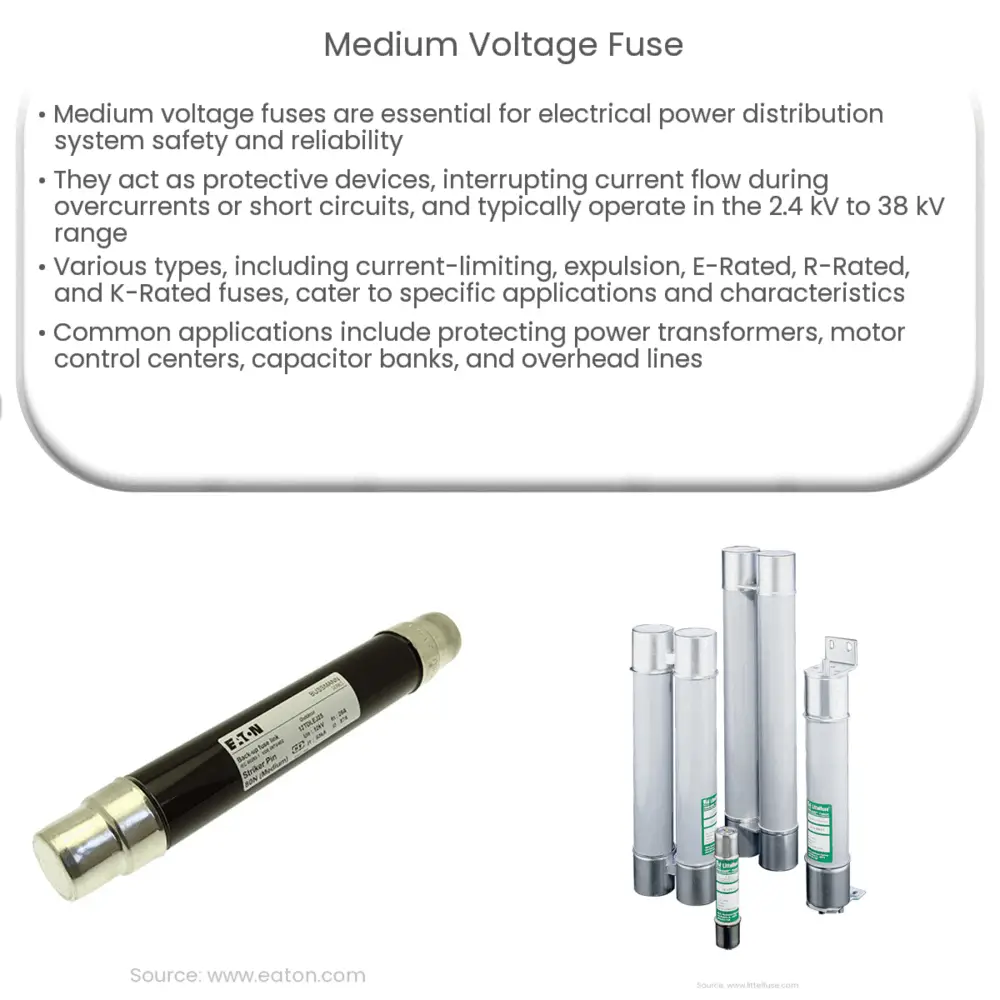Medium voltage fuses safeguard electrical systems by interrupting current flow during overcurrents or short circuits, ensuring safety and reliability.

Understanding Medium Voltage Fuses: An Overview
Introduction
Medium voltage fuses are a critical component in electrical power distribution systems, providing essential protection against electrical faults and ensuring the safety and reliability of the network. This article will delve into the characteristics, types, and applications of medium voltage fuses, highlighting their significance in modern power systems.
What are Medium Voltage Fuses?
Medium voltage fuses are protective devices designed to interrupt current flow in the event of an overcurrent or short circuit, preventing potential damage to electrical equipment and minimizing the risk of fires or electrical hazards. They are typically used in power distribution networks with voltage levels ranging from 2.4 kV to 38 kV.
These fuses contain a fusible element made of a conductive material, usually silver or copper, which melts and disconnects the circuit when the current exceeds a predetermined threshold. This action isolates the faulty section of the network, allowing the rest of the system to continue functioning without disruption.
Types of Medium Voltage Fuses
There are several types of medium voltage fuses available, each designed for specific applications and characteristics. Some of the most common types include:
1. Current-limiting Fuses
Current-limiting fuses are designed to limit the fault current by rapidly disconnecting the circuit when an overcurrent condition occurs. This type of fuse is highly effective in reducing the damaging effects of high fault currents on electrical equipment and can also help reduce the likelihood of arc flash incidents.
2. Expulsion Fuses
Expulsion fuses utilize a fuse link enclosed within a gas-tight, non-conductive tube. When the fuse link melts due to an overcurrent event, an arc is generated within the tube, causing the gas pressure to rise and expel the arc from the tube, effectively interrupting the current. Expulsion fuses are commonly used in distribution transformers and overhead lines.
3. E-Rated Fuses
E-Rated fuses are specifically designed for the protection of power transformers and have a pre-defined current-time characteristic that allows them to coordinate with other protective devices in the system. They offer a high degree of fault discrimination and can selectively isolate the faulted transformer while minimizing the impact on the rest of the network.
4. R-Rated Fuses
R-Rated fuses are used primarily for the protection of medium voltage motors and their associated control equipment. They are designed to handle the high inrush currents associated with motor starting and provide reliable protection against short circuits and overloads.
5. K-Rated Fuses
K-Rated fuses are designed to offer fast-acting protection for capacitor banks and harmonic filter circuits. They have a unique current-time characteristic that enables them to quickly detect and interrupt fault conditions, protecting sensitive components from damage caused by overcurrents and inrush currents.
Applications of Medium Voltage Fuses
Medium voltage fuses play a vital role in various applications, ensuring the safety and reliability of electrical power systems. Some common applications include:
- Power Transformers: Fuses are used to protect transformers from internal faults, such as winding short circuits, and external faults, such as lightning strikes or contact with foreign objects.
- Motor Control Centers: Fuses protect medium voltage motors and their control equipment from short circuits and overloads, preventing costly equipment damage and downtime.
- Capacitor Banks: Fuses are utilized to safeguard capacitor banks from overcurrents, ensuring the proper functioning and longevity of these critical components.
- Overhead Lines: Fuses provide protection for overhead lines and associated equipment from lightning strikes, contact with foreign objects, and other fault conditions.
Conclusion
Medium voltage fuses are an indispensable component of modern electrical power distribution systems, providing critical protection against a variety of fault conditions. By understanding the different types of medium voltage fuses and their applications, engineers and technicians can ensure the safety and reliability of power systems and equipment, ultimately minimizing the risk of costly damage and downtime.
References
- ANSI/IEEE Standard C37.40-2003, “IEEE Standard Specifications for Surge Arresters.
- ANSI/IEEE Standard C37.41-2008, “IEEE Standard Design and Tests for High-Voltage Fuses, Distribution Enclosed Single-Pole Air Switches, Fuse Disconnecting Switches, and Accessories.
- NEMA SG 5-2018, “Guide for the Application of Medium Voltage Fuses in Industrial and Commercial Power Systems.

